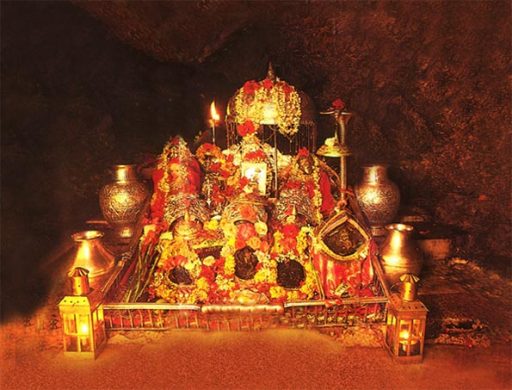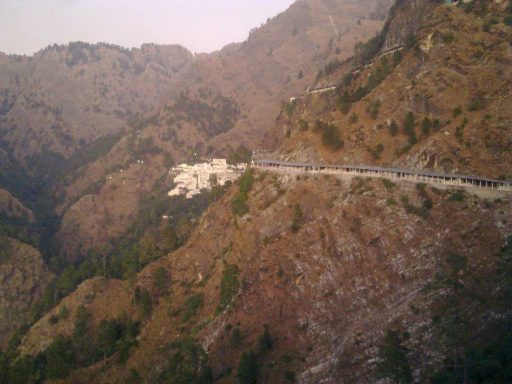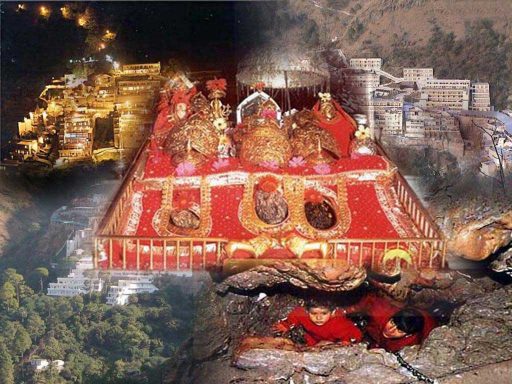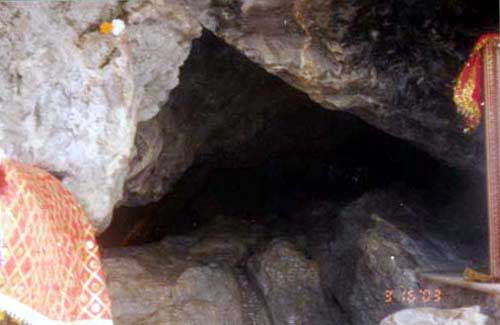
Jai Maa Vaishnavi
Darshani Darwaaza
As per the legend, Mata Vaishno Devi met Pandit Shridhar in the form of a girl child at the spot which is today known as the Darshani Darwaza. This spot is also known because Darshani Darwaaza because from here one gets a complete view of Trikuta Mountain.

Terk To Maa Vaishno Devi Bhawan
Holy Track: Old Track
In the earlier days, there used to be an unpaved track and a few flights of stairs that used to lead the way to Bhawan. This track called the old or original track was mostly built on the traditional track of Shri Mata Vaishno Devi Ji, which had been used by the pilgrims since hundreds of years. Then, after the takeover of the management of the Holy Shrine by Shri Mata Vaishno Devi Shrine Board in 1986.
Holy Track: New or Alternate Track
The old track is steep and narrow at some places. Therefore it was decided to construct an alternate track to Bhawan that would have a gentler gradient and would be wider and shorter.
Ban Ganga
Situated on the bank of a small rivulet called Banganga and at a height of 2700 ft., Banganga is the first major station for a yatri when he undertakes his on-foot journey from Katra to Bhawan. As per the legend, the goddess, accompanied by Langoor-Veer was moving to her destined abode in the Trikuta Hills, when Langoor-veer felt thirsty. The goddess shot an arrow into the ground and a spring gushed out.
Charan Paduka
The ancient temple of Charun Paduka, situated at a distance of nearly one Km from Banganga, is also connected to the legend of goddess Vaishno Devi. As per the Legend, the goddess stopped at this place for a while to look back and check whether Bhairon Nath was still chasing her or not. Due to Her standing there for a while, her footprints got engraved there, hence the name.
Adhkuwari
The word Adhkuwari means Eternal virgin. At this place the Goddess is believed to have worshiped Lord Shiva in a cave for 9 months and when Bhairo Nath discovered her inside the cave She made an opening in the cave with her trident and proceeded towards Bhawan. Adkuwari also marks the midpoint of the Yatra and most pilgims like to rest here for a while and refresh themselves.
Himkoti
Himkoti is situated at a distance of 2.75 kms from Adkuwari on the new track. Himkoti is one of the most beautiful spots on this track with breathtaking scenic views of the entire valley. Although there is no traditional or religious significance associated with this point, yet the very nature of this spot and its natural splendour envelops the pilgrims in a ethereal and mysterious charm. Shri Mata Vaishno Devi Shrine Board has developed a view point, restaurant and a dosa counter here. Packed and cooked food including meals, hot and cold beverages and other important items including medicare and oxygen cylinders, cassettes are available here. There is adequate place to rest and relax and also enjoy the beauty of nature. Himkoti is being developed something more than a view point, with an artificial pond, a garden and a meditation centre.
Sanjhichhat
Sanjhichhat is the highest point for the pilgrims on their trek to the Holy Bhawan. The place is situated at a height of about 6,200 feet above the sea level, and presents a panoramic view of the landscape below. The final destination is about 2 km. away from this point.The Helipad is also located at this point.

Maa Vaishno Devi Temple
Reached Maa Ke Bhawan
The Holy Bhawan houses the Sanctum Sanctorum – the Holy cave which is the ultimate destination of the yatries. Inside the Holy Cave the Goddess has revealed herself in the form of Holy Pindies manifesting Mata in her three forms Maha Kali, Maha Lakshmi and Mata Saraswati.
Obtaining a Group Number
Yatries would recollect that prior to the commencement of their yatra, they had obtained a Yatra Registration Slip or Parchi from the Yatra Registration Counter (YRC) located at Katra. This slip had been checked and stamped at Banganga. The most important role of the slip is at Bhawan, where the slip is revalidated and used to issue a group number. The group number is allotted at the Yatra Slip Counter located on the left hand side immediately after the luggage check post. This group number would then determine the sequence in which the yatries would have the Holy Darshan and the time for which they would have to wait before obtaining Darshans.
Facilities available at Bhawan
The Shrine Board has provided various facilities for the yatries at Bhawan, to facilitate comfortable Darshans.
Preparing for Darshans
Most pilgrims prefer to take a bath before proceeding for Darshans. In the olden days pilgrims used to take a bath at the Bathing Ghat, with the water that flows from the feet of Mata. With the passage of time, and particularly after the vesting of the management in the Shrine Board, new Bathing ghats and many toilets and bathrooms have been constructed. Attempts have been made to channelise the water from the Holy Cave to all these new Bathing areas, so that irrespective of where the pilgrim takes a bath, he receives the cleansing effect of the Holy Water.
Waiting in Queue
Immediately after a pilgrim’s group number is called or displayed, he/she is ushered in through Gate No.1 into the queue complex. The queue complex is a long corridor which opens first into two large waiting halls, one after the other and finally opens at the mouth of the Holy Cave.
Coconut Prasad Counter
The traditional offering to the Goddess invariably comprises a coconut. However for reasons of time and security, coconut offerings are not allowed to be carried by the pilgrims beyond a designated point.

Shri Mata Vaishno Holy Shrine Cave
The Original Cave & New Tunnel
While on the way to the Sanctum Sanctorum, one crosses a small patio type of structure on the right hand side of which is a Cave opening. This is the original Cave leading to the Holy Pindies. In the olden days, the yatries used to reach the Sanctum Sanctorum through this cave only. Nowadays, this cave is kept closed for a large part of the year. Since this cave is quite narrow, it takes several minutes for a single person to cross it and reach the Sanctum Sanctorum.
Ornamentation
The ornamentation of the Holy Pindies was done gradually over a period of time since the discovery of the Holy Shrine. Various devotees offered jewelry, crowns, Chhatras, idols etc, for the ornamentation of the Holy Pindies. The same ornamentation continued all these years and everything was kept practically untouched. Various idols and statues donated by the Kings and placed in the Sanctum Sanctorum were also visible immediately behind the Pindies.
Amrit Kund & Charan Ganga
Just outside the exit tunnel, towards the left hand side of the Cave is the Amrit Kund. This comprises the water taps through which flows the water of the Charan Ganga, the sacred water flowing from the feet of Mata. Pilgrims prefer to fill the Holy Water called Charanamrit in bottles and take it along with them for purification of their residences and cure of various ailments.
Prasad
Outside the exit tunnel and just beyond the Amrit Kund lies the Prashad counter. The blessings of the Mother Goddess in the form of Prashad pouches are handed over to the devotees by the temple priests. Each Prashad pouch comprises the Mishri Prashad plus a blessed coin, carrying the image of the Holy Pindies. In addition, Khazaana (coins) are given to the devotees. This Khazaana Prashad is believed to be a good luck coin(s) and devotees would do well to keep it in their cash boxes, temples or other important places in their homes or establishments.
Coconut Reclaim Counter
Yatries would recollect that Coconut Prashad had been handed over by them to the temple priests in the Waiting Hall and a token had been received in lieu of it. This token is now exchange for the blessed coconut at the Coconut Prashad counter. This counter is located on the right of the exit route.
Other Darshans Inside Cave
The Holy Cave is around 98 feet long. Besides the main Darshans of the Pindies inside the Cave, there are various other Darshans, outside and inside the Holy Cave and around the Holy Pindies. It is believed that the Darshans of 33 crore (330 million) Gods and Goddesses are present in the Holy Cave. It is believed that at some given point of time, each of the 330 million gods and goddesses have worshipped the Mother Goddess in the Holy Cave and have left their symbolical marks inside.
Other Darshans at Bhawan
There are other Darshans in the Bhawan area as well. These include Darshans of Lord Shiva’s Shivling in a cave, Mata Durga, Lord Shiv, Shri Ram with Sita and Lakshman, Lord Hanuman etc. These Darshans are in temples situated at different point of the Bhawan complex. Signboards have been put up at Bhawan to guide the yatries as to the location of these temples.
Bhairon Ghati
Bhairon temple is the next halt for the pilgrims after visiting the holy Shrine of Mata Vaishno Devi Ji. This old temple is significant from the point of view of a holy legend associated with the Shrine. After beheading Bhairon Nath and after his profuse repentance, the Almighty Mother Goddess forgave and blessed him and granted him the boon that the Darshans of his temple would be the final link of Her Great Pilgrimage. Thus, for the full blessings of the journey to Mata Vaisno Deviji, Yatries would have to pay obedience at Bhairon temple on their return.
Please Note:- This site is just an informational site, for full details about Yatara to Maa Vaisnho Devi Dhaam Please Visit : MaaVaishnoDevi.org